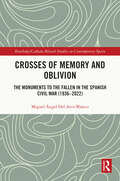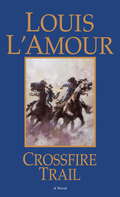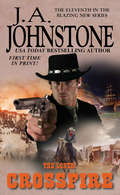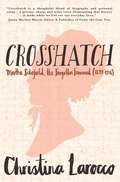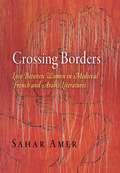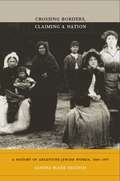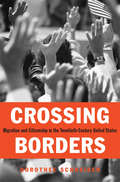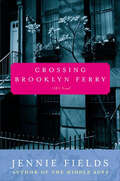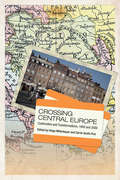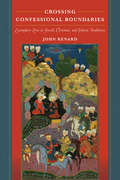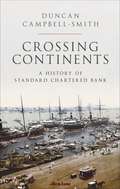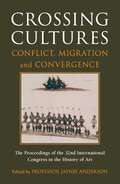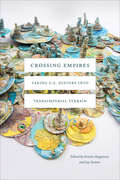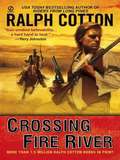- Table View
- List View
Crosses of Memory and Oblivion: The Monuments to the Fallen in the Spanish Civil War (1936-2022) (Routledge/Canada Blanch Studies on Contemporary Spain)
by Miguel Ángel del Arco BlancoThis book explores the history and legacy of monuments to the fallen from the Francoist side in the Spanish Civil War. Del Arco Blanco studies thousands of monuments in towns and cities across Spain to provide a detailed account of the history and memory of the civil war, Francoism, and the transition to democracy. Chapters in the book focus on the myth of those said to have 'fallen for God and for Spain'—a phrase that encapsulated and shaped the dichotomy between ‘good’ and ‘bad’ Spaniards. They also focus on the use of monuments to control political and ideological ideals and to legitimise the Francoist dictatorship. Further chapters study Spanish society’s struggle to deal with its past of mass killing, denial, and exclusion. Del Arco Blanco also pays attention to the way the Francoist authorities used monuments and memory for their political and ideological advantage and to control people, power as well as the political agenda. The book draws on extensive research to reconstruct both the specific history of monuments scattered throughout the country and their role within manipulative Francoist memory of the Spanish Civil War. In these ways, monuments helped shape the Francoist narrative and memory, but they also became part of the landscape of contemporary Spanish history. This book is an excellent resource for postgraduate students and professional researchers studying the aftermath of the Spanish Civil War, and the influence of monuments on the construction of national memory, culture, and society in Spain both at the time and through to the present day.
Crossfire
by Wilbur SmithA race against time Courtney series thriller from the Master of Adventure, Wilbur SmithIt's 1943 and the tides of the Second World War are changing: the Germans are losing and the Allies are on their way. Special Operations Executive, Saffron Courtney - daughter of the celebrated soldier Leon Courtney - is sailing from the west coast of Scotland to New York on the Queen Mary. Her mission is two-fold: to gather support for SOE, but, more treacherously, to uncover a Nazi spy ring and a mole deep within the British Embassy. As Churchill and Roosevelt, two of the most powerful men on earth, are about to begin talks that will determine British and American military strategy for the next two years, it is vital that the enemy don't find out their secrets. Meanwhile, what Saffron doesn't realise is that while she is on the tail of a dangerous spy, there are equally dangerous agents after her, desperate for justice following the death of Hauptsturmführer Schröder, a powerful Nazi she killed in self-defence. With time running out, and the safety of not only the nation, but Saffron herself, under threat, can she uncover the truth and expose the dangerous plots before it's too late?
Crossfire Trail
by Louis L'AmourRafe Caradec--gambler, wanderer, soldier of fortune--was as hard a man as the battlefields and waterfronts of Latin America could fashion, but he was as good as his word. As Charles Rodney lay dying in a dank ship's fo'c'sle, Rafe swore to make sure that Rodney's Wyoming ranch went to his daughter, Ann. In Painted Rock, Wyoming, Caradec found land for a man to love, miles of rolling grasslands and towering mountains. He also found that one of the most ruthless men in the territory had set his sights on both Rodney's ranch and his daughter. But Rafe Caradec had given his word, and once he'd looked deep into Ann Rodney's eyes, nothing short of death would stop him from keeping the promise he'd made.From the Paperback edition.
Crossfire: Crossfire (The Loner #11)
by J.A. JohnstoneThe Loner&’s desperate search for his missing children ends—and the fight begins—in this Western adventure from the USA Today–bestselling author.HELL ON FRISCO BAYConrad Browning is The Loner, a man on a mission, crossing the country—and crossing a lot of bad men—to rescue his kidnapped young twins. The trail has led him all the way to San Francisco&’s perilous red-light district, where a crime lord is the proud father of newly adopted twins. The Loner knows his children when he sees them. But they&’re hostage to a brutal, violent mob feud. Then, just when he needs it most, The Loner is no longer alone: he is joined by his own father, Frank Morgan—the most notorious gunman in the West.A family&’s pain. A woman&’s betrayal. A city exploding in violence . . . The Loner has come to the right place to save his children. But will they get out of Frisco alive?&“An excellent story that pulls you in . . . [A] terrific, twist ending. Top class entertainment that left me looking forward to reading the next book in the series.&” —Western Fiction Review
Crossfire: The Plot That Killed Kennedy
by Jim MarrsWhat really happened in Dallas on November 22, 1963? Was the assassination of John F. Kennedy simply the work of a warped, solitary young man, or was something more nefarious afoot? Pulling together a wealth of evidence, including rare photos, documents, and interviews, veteran Texas journalist Jim Marrs reveals the truth about that fateful day. Thoroughly revised and updated with the latest findings about the assassination, Crossfire is the most comprehensive, convincing explanation of how, why, and by whom our thirty-fifth president was killed.
Crosshatch: Martha Schofield, the Forgotten Feminist (1839–1916)
by Christina LaroccoIf Louisa May Alcott had imagined a fifth March sister, she might have been a lot like activist and educator Martha Schofield (1839–1916): passionate about equality, determined to break free from the restrictions of nineteenth-century society, yearning equally for both purpose and love. Crosshatch follows Schofield from the Underground Railroad outposts of southeastern Pennsylvania to war-ravaged South Carolina. As an abolitionist, a women's suffragist, and a white teacher of Black students, she spent a lifetime attempting to develop (however imperfectly) an antiracist feminist vision. Based on Schofield's letters and diaries, Crosshatch provides unparalleled access to the intimate details of a nineteenth-century woman's personal life: her love affairs with both women and men, her rocky mental and physical health, her thoughts as she watched wounded soldiers die after the Battle of Gettysburg or stared down Ku Klux Klan members during Reconstruction. More than a biography, Crosshatch uses Schofield's life to make sense out of our own chaotic times. It is a testament to the power of history to shape our lives and to the urgency of listening to women's voices.
Crossing Bok Chitto: A Choctaw Tale of Friendship and Freedom
by Tim TingleThere is a river called Bok Chitto that cuts through Mississippi. In the days before the War Between the States, in the days before the Trail of Tears, Bok Chitto was a boundary. On one side of the river lived the Choctaws. On the other side lived the plantation owners and their slaves. If a slave escaped and made his way across Bok Chitto, the slave was free.
Crossing Bok Chitto: A Choctaw Tale of Friendship and Freedom (Into Reading, Trade Book #4)
by Tim Tingle Jeanne Bridges<p>There is a river called Bok Chitto that cuts through Mississippi. In the days before the War Between the States, in the days before the Trail of Tears, Bok Chitto was a boundary. On one side of the river lived the Choctaws. On the other side lived the plantation owners and their slaves. If a slave escaped and made his way across Bok Chitto, the slave was free. <p>Thus begins Crossing Bok Chitto, told by award-winning Choctaw storyteller Tim Tingle and brought to life with the rich illustrations of Jeanne Rorex Bridges. <p>Martha Tom, a young Choctaw girl, knows better than to cross Bok Chitto, but one day—in search of blackberries—she disobeys her mother and finds herself on the other side. A tall slave discovers Martha Tom. A friendship begins between Martha Tom and the slave’s family, most particularly his young son, Little Mo. Soon afterwards, Little Mo’s mother finds out that she is going to be sold. The situation seems hopeless, except that Martha Tom teaches Little Mo’s family how to walk on water to their freedom.</p>
Crossing Borders
by Sahar AmerGiven Christianity's valuation of celibacy and its persistent association of sexuality with the Fall and of women with sin, Western medieval attitudes toward the erotic could not help but be vexed. In contrast, eroticism is explicitly celebrated in a large number of theological, scientific, and literary texts of the medieval Arab Islamicate tradition, where sexuality was positioned at the very heart of religious piety.In Crossing Borders, Sahar Amer turns to the rich body of Arabic sexological writings to focus, in particular, on their open attitude toward erotic love between women. By juxtaposing these Arabic texts with French works, she reveals a medieval French literary discourse on same-sex desire and sexual practices that has gone all but unnoticed. The Arabic tradition on eroticism breaks through into French literary writings on gender and sexuality in often surprising ways, she argues, and she demonstrates how strategies of gender representation deployed in Arabic texts came to be models to imitate, contest, subvert, and at times censor in the West.Amer's analysis reveals Western literary representations of gender in the Middle Ages as cross-cultural, hybrid discourses as she reexamines borders--cultural, linguistic, historical, geographic--not as elements of separation and division but as fluid spaces of cultural exchange, adaptation, and collaboration. Crossing these borders, she salvages key Arabic and French writings on alternative sexual practices from oblivion to give voice to a group that has long been silenced.
Crossing Borders, Claiming a Nation: A History of Argentine Jewish Women, 1880-1955
by Sandra Mcgee DeutschIn Crossing Borders, Claiming a Nation, Sandra McGee Deutsch brings to light the powerful presence and influence of Jewish women in Argentina. The country has the largest Jewish community in Latin America and the third largest in the Western Hemisphere as a result of large-scale migration of Jewish people from European and Mediterranean countries from the 1880s through the Second World War. During this period, Argentina experienced multiple waves of political and cultural change, including liberalism, nacionalismo, and Peronism. Although Argentine liberalism stressed universal secular education, immigration, and individual mobility and freedom, women were denied basic citizenship rights, and sometimes Jews were cast as outsiders, especially during the era of right-wing nacionalismo. Deutsch's research fills a gap by revealing the ways that Argentine Jewish women negotiated their own plural identities and in the process participated in and contributed to Argentina's liberal project to create a more just society. Drawing on extensive archival research and original oral histories, Deutsch tells the stories of individual women, relating their sentiments and experiences as both insiders and outsiders to state formation, transnationalism, and cultural, political, ethnic, and gender borders in Argentine history. As agricultural pioneers and film stars, human rights activists and teachers, mothers and doctors, Argentine Jewish women led wide-ranging and multifaceted lives. Their community involvement--including building libraries and secular schools, and opposing global fascism in the 1930s and 1940s--directly contributed to the cultural and political lifeblood of a changing Argentina. Despite their marginalization as members of an ethnic minority and as women, Argentine Jewish women formed communal bonds, carved out their own place in society, and ultimately shaped Argentina's changing pluralistic culture through their creativity and work.
Crossing Borders: Migration and Citizenship in the Twentieth-Century United States
by Dorothee SchneiderAspiring immigrants to the United States make many separate border crossings in their quest to become Americans—in their home towns, ports of departure, U.S. border stations, and in American neighborhoods, courthouses, and schools. In a book of remarkable breadth, Dorothee Schneider covers both the immigrants’ experience of their passage from an old society to a new one and American policymakers’ debates over admission to the United States and citizenship. Bringing together the separate histories of Irish, English, German, Italian, Jewish, Chinese, Japanese, and Mexican immigrants, the book opens up a fresh view of immigrant aspirations and government responses. Ingenuity and courage emerge repeatedly from these stories, as immigrants adapted their particular resources, especially social networks, to make migration and citizenship successful on their own terms. While officials argued over immigrants’ fitness for admission and citizenship, immigrant communities forced the government to alter the meaning of race, class, and gender as criteria for admission. Women in particular made a long transition from dependence on men to shapers of their own destinies. Schneider aims to relate the immigrant experience as a totality across many borders. By including immigrant voices as well as U.S. policies and laws, she provides a truly transnational history that offers valuable perspectives on current debates over immigration.
Crossing Boundaries, Building Bridges (Routledge Studies in the History of Science, Technology and Medicine #Vol. 12)
by Ruth Oldenziel Annie CanelWomen engineers have been in the public limelight for decades, yet we have surprisingly little historically grounded understanding of the patterns of employment and education of women in this field. Most studies are either policy papers or limited to statistical analyses. Moreover, the scant historical research so far available emphasizes the individual, single and unique character of those women working in engineering, often using anecdotal evidence but ignoring larger issues like the patterns of the labour market and educational institutions.Crossing Boundaries, Building Bridges offers answers to the question why women engineers have required special permits to pass through the male guarded gates of engineering and examines how they have managed this. It explores the differences and similarities between women engineers in nine countries from a gender point of view. Through case studies the book considers the mechanisms of exclusion and inclusion of women engineers.
Crossing Broadway: Washington Heights and the Promise of New York City
by Robert W. SnyderRobert W. Snyder's Crossing Broadway tells how disparate groups overcame their mutual suspicions to rehabilitate housing, build new schools, restore parks, and work with the police to bring safety to streets racked by crime and fear. It shows how a neighborhood once nicknamed "Frankfurt on the Hudson" for its large population of German Jews became "Quisqueya Heights"—the home of the nation's largest Dominican community.The story of Washington Heights illuminates New York City's long passage from the Great Depression and World War II through the urban crisis to the globalization and economic inequality of the twenty-first century. Washington Heights residents played crucial roles in saving their neighborhood, but its future as a home for working-class and middle-class people is by no means assured. The growing gap between rich and poor in contemporary New York puts new pressure on the Heights as more affluent newcomers move into buildings that once sustained generations of wage earners and the owners of small businesses.Crossing Broadway is based on historical research, reporting, and oral histories. Its narrative is powered by the stories of real people whose lives illuminate what was won and lost in northern Manhattan's journey from the past to the present. A tribute to a great American neighborhood, this book shows how residents learned to cross Broadway—over the decades a boundary that has separated black and white, Jews and Irish, Dominican-born and American-born—and make common cause in pursuit of one of the most precious rights: the right to make a home and build a better life in New York City.
Crossing Brooklyn Ferry: A Novel
by Jennie FieldsEscaping the narrow, wealthy life she led in Manhattan, Zoe Finney moves her family to Park Slope, Brooklyn, an area of beautiful old brownstones where working-class families have lived for generations.A poor girl who married into money, Zoe finds comfort in the close-knit neighborhood.She hopes the change will reinvigorate her profoundly depressed husband and provide a happy place for her small daughter, Rose, to grow.But her arrival there alters the lives around her, especially the handsome schoolteacher next door, Keevan O'Connor, who is deeply drawn to her. Despite Zoe's initial hesitation, they begin to fall in love. Rose is thrilled, recognizing in Keevan the warm, fun-loving father hers could never be. But when Zoe's husband wakes from his depression to see his wife slipping away, Zoe is torn between her love for two men.
Crossing California
by Adam LangerSet in Chicago's Jewish neighborhood of West Rogers Park, this is the story of three families--adults and children alike--coming of age during the tumultuous, turbulent days of the Iran hostage crisis. At the close of the 1970s, the Rovners, the Wasserstroms, and the Wills-Silvermans will have to shed their pasts to cross into that new, shining decade of hope: the 80s. Be sure to read to the end for a reader's guide.
Crossing Central Europe: Continuities and Transformations, 1900-2000
by Carrie Smith-Prei Helga MitterbauerCrossing Central Europe is a pioneering volume that focuses on the complex networks of transcultural interrelations in Central Europe from 1900 to 2000. Scholars from Canada, the United States, and Europe identify the motifs, topics, and ways of artistic creation that define this cross-cultural region. This interdisciplinary volume is divided into two historical periods and includes analyses of literature, film, music, architecture, and media. By focusing first on the interrelations in the nineteenth and early twentieth-century, the contributors reveal a complex trans-ethnic network at play that disseminated aesthetic ideals. This network continued to be a force of aesthetic influence leading into the twenty-first century despite globalization and the influence of mass media. Helga Mitterbauer and Carrie Smith-Prei have embarked on a study of the overlapping artistic influences that have outlasted both the National Socialist regime and the Cold War.
Crossing Confessional Boundaries: Exemplary Lives in Jewish, Christian, and Islamic Traditions
by John RenardArguably the single most important element in Abrahamic cross-confessional relations has been an ongoing mutual interest in perennial spiritual and ethical exemplars of one another’s communities. Ranging from Late Antiquity through the Middle Ages, Crossing Confessional Boundaries explores the complex roles played by saints, sages, and Friends of God in the communal and intercommunal lives of Christians, Muslims, and Jews across the Mediterranean world, from Spain and North Africa to the Middle East to the Balkans. By examining these stories in their broad institutional, social, and cultural contexts, Crossing Confessional Boundaries reveals unique theological insights into the interlocking histories of the Abrahamic faiths.
Crossing Continents: A History of Standard Chartered Bank
by Duncan Campbell-SmithFor almost a hundred years from the 1860s, the City of London's overseas banks financed the global trade that lay at the core of the British Empire. Foremost among them from the beginning were two start-up ventures: the Standard Bank of South Africa, which soon developed a powerful domestic franchise at the Cape, and the Chartered Bank of India, Australia and China. This book traces their stories in the nineteenth century, their glory days before 1914 - and their remarkable survival in the face of global wars and the collapse of world trade in the first half of the twentieth century.The unravelling of the Empire after 1945 eventually forced Britain's overseas banks to confront a different future. The Standard and the Chartered, alarmed at the expansion of American banking, determined in 1969 on a merger as a way of sustaining the best of the City's overseas traditions. But from the start, Standard Chartered had to grapple with the fading fortunes of its own inherited franchise - badly dented in both Asia and Africa - and with radical changes in the nature of banking. Its British managers, steeped in the past, proved ill-suited to the challenge. By the late 1980s, efforts to expand in Europe and the USA had brought the merged Group to the brink of collapse.Yet it survived - and then pulled off a dramatic recovery. Standard Chartered realigned itself, just in time, with the phenomenal growth of Asia's 'emerging markets', many of them in countries where the Chartered had flourished a century earlier. In the process, the Group was transformed. Trebling its workforce, it brushed aside the global financial crisis of 2008 and by 2012 could look back on a decade of astonishing growth. Recent times have added an eventful postscript to a long and absorbing history.Crossing Continents recounts Standard Chartered's story with a wealth of detail from one of the richest archives available to any commercial bank. The book also affords a rare and compelling perspective on the evolution of international trade and finance, showing how Britain's commercial influence has actually worked in practice around the world over one hundred and fifty years.
Crossing Cultures in Scripture: Biblical Principles for Mission Practice
by Marvin J. Newell14th Annual Outreach Magazine Resource of the Year, Cross-Cultural Category
Crossing Cultures: Conflict, Migration and Convergence
by Jaynie AndersonCrossing Cultures: Conflict, Migration and Convergence is an in-depth examination of the effect of globalism on art and art history. Covering all aspects of art; including traditional media, painting, sculpture, architecture and the crafts, as well as design, film, visual performance and new media; it explores the themes of conflict, migration and convergence in the visual, symbolic and artistic exchanges between cultures throughout history. Crossing Cultures is a compilation of the conference papers from the 32nd International Congress in the History of Art organised by the International Committee of the History of Art (CIHA), edited by conference convenor Professor Jaynie Anderson. This volume contains more than 200 papers presented at the congress by art historians from twenty-five countries, including Homi K Bhabha (Harvard University), Michael Brand (Director of the John Paul Getty Museum, Los Angeles), Marcia Langton (Chair of Australian Indigenous Studies, University of Melbourne), Ronald de Leeuw (Director of the Rijksmuseum, Amsterdam), Neil McGregor (Director of the British Museum, London) and Ruth B Phillips (Canada Research Chair in Modern Culture and Professor of Art History, Carleton University, Ottawa). Never before has the state of art history in our polycentric world been demonstrated so well. Crossing Cultures encourages fresh thinking about global art history.
Crossing Ebenezer Creek
by Tonya Bolden<p>When Mariah and her young brother Zeke are suddenly freed from slavery, they join Sherman's march through Georgia. Mariah wants to believe that the brutalities of slavery are behind them, but even as hope glimmers, there are many hardships yet to come. When she meets a free black named Caleb, Mariah dreams in a way she never dared . . . of a future worth living and the possibility of true love. But even hope comes at a cost, and as the difficult march continues toward the churning waters of Ebenezer Creek, Mariah's dreams are as vulnerable as ever. <p>In this powerful exploration of a little-known tragedy perfect for fans of Ruta Sepetys, readers will never forget the souls of Ebenezer Creek.</p>
Crossing Empires: Taking U.S. History into Transimperial Terrain (American Encounters/Global Interactions)
by Jay Sexton Kristin HogansonWeaving U.S. history into the larger fabric of world history, the contributors to Crossing Empires de-exceptionalize the American empire, placing it in a global transimperial context. They draw attention to the breadth of U.S. entanglements with other empires to illuminate the scope and nature of American global power as it reached from the Bering Sea to Australia and East Africa to the Caribbean. With case studies ranging from the 1830s to the late twentieth century, the contributors address topics including diplomacy, governance, anticolonialism, labor, immigration, medicine, religion, and race. Their transimperial approach—whether exemplified in examinations of U.S. steel corporations partnering with British imperialists to build the Ugandan railway or the U.S. reliance on other empires in its governance of the Philippines—transcends histories of interimperial rivalries and conflicts. In so doing, the contributors illuminate the power dynamics of seemingly transnational histories and the imperial origins of contemporary globality.
Crossing Fandoms: SuperWhoLock and the Contemporary Fan Audience
by Paul BoothThis book examines the fan-created combination of Doctor Who, Sherlock, and Supernatural as a uniquely digital fan experience, and as a metaphor for ongoing scholarship into contemporary fandom. What do you get when you cross the cult shows Doctor Who, Supernatural, and Sherlock? In this book, Paul Booth explores the fan-created crossover universe known as SuperWhoLock--a universe where Sherlock Holmes and Dean Winchester work together to fight monsters like the Daleks and the Weeping Angels; a world where John Watson is friends with Amy Pond; a space where the unique brands of fandom interact. Booth argues that SuperWhoLock represents more than just those three shows--it is a way of doing fandom. Through interviews with fans and analysis of fan texts, Crossing Fandoms: SuperWhoLock and the Contemporary Fan Audience also demonstrates how fan studies in the digital age can evolve to take into account changing fan activities and texts.
Crossing Fire River
by Ralph CottonLawrence Shaw is well-known as the fastest gun alive-and for other reasons he'd just as soon forget. But when he kills two bushwhacking banditos, he becomes quarry for ruthless bounty hunters led by a cunning Mexican agent-and finds a chance for redemption. . . .
Crossing Great Divides: City and Country in Environmental and Political Disorder (Urban Life, Landscape and Policy)
by John D. FairfieldRanging across two centuries of American history, Crossing Great Divides argues that the habit of construing city and country as opposites is at the root of our current environmental and political disorder. This oversimplifying dualism has distorted how we planned cities, our patterns of production and consumption, how we deal with waste, and how urban and rural populations perceive each other. Conventional urban environmental reform has made modern city life possible, but it has done little to limit the despoliation of distant places. Nevertheless, the successes of urban environmental reform remind us of what is possible. John Fairfield concludes with a case study of Phoenix, Arizona to demonstrate this dysfunctional relationship between city and country while developing a sympathetic critique of the Green New Deal. He suggests how we might bridge the “great divide” as we face the daunting challenges the twenty-first century is pressing upon us.
